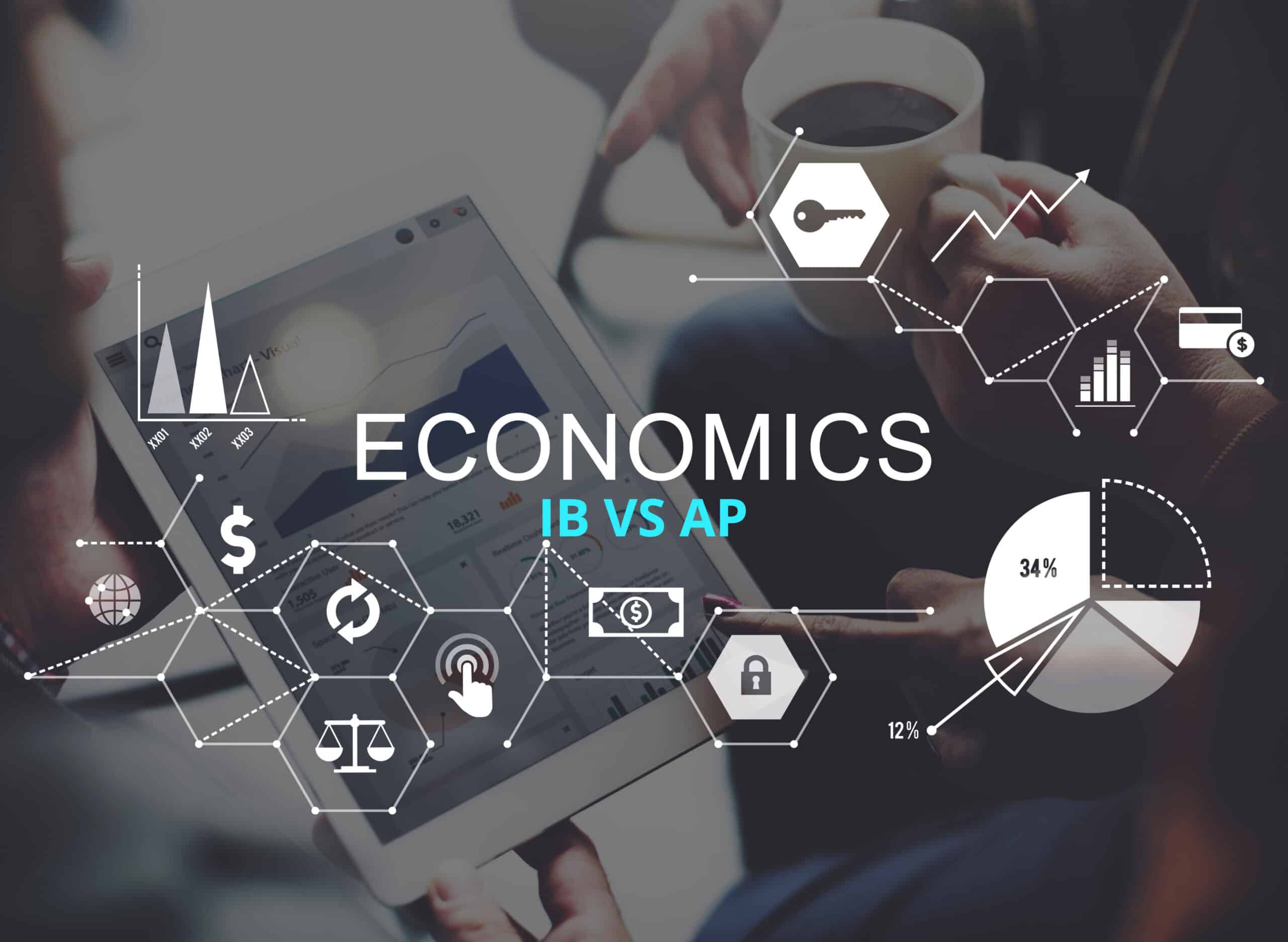
Comparative Guide to IB Economics and AP Economics: Course Structure, Content, and Exam Breakdown
Understanding the Structure and Timing of AP Multiple-Choice and Free-Response Sections
Both AP Exams are 2 hours and 10 minutes long and both have two sections. Section 1 includes 60 multiple-choice questions and section 2 has 3 “free-response” questions. A four-function calculator is allowed in both sections of the exam.
The multiple-choice (section 1) allows 70 minutes to complete 60 questions, so keeping pace is crucial. This section is also weighted as ⅔ of the final grade.
Content Distribution in AP Microeconomics
While the approach to the IB exam is to cover the entire course content without placing specific emphasis on any one topic (except for paper 3, which is exclusive to HL material), the strategy for the AP Macroeconomics exam is notably different. In the AP exam, the multiple-choice questions are broken down as follows:
| Units | Topics | AP Exam Weight (%) |
|---|---|---|
| Basic economics concepts | Scarcity, Opportunity Cost and the Production Possibilities Curve (PPC), Comparative Advantage and Gains from Trade, Demand, Supply, Market Equilibrium, Disequilibrium and Changes in Equilibrium | 5-10 |
| Economic Indicators and the Business Cycle | The Circular Flow and GDP, Limitations of GDP, Unemployment, Price Indices and Inflation, Costs of Inflation, Real v. Nominal GDP, Business Cycles | 12-17 |
| National Income and price determination | Aggregate Demand (AD), Multipliers, Short-Run Aggregate Supply (SRAS), Long-Run Aggregate Supply (LRAS), Equilibrium in the Aggregate Demand– Aggregate Supply (AD–AS) Model, Changes in the AD–AS Model in the Short Run, Long-Run Self-Adjustment, Fiscal Policy, Automatic Stabilizers | 17-27 |
| Financial Sectors | Financial Assets, Nominal v. Real Interest Rates, Definition, Measurement, and Functions of Money, Banking and the Expansion of the Money Supply,The Money Market, Monetary Policy, The Loanable Funds Market | 18-23 |
| Long Run consequences of Stabilization Policies | Fiscal and Monetary Policy Actions in the Short Run, The Phillips Curve, Money Growth and Inflation, Government Deficits and the National Debt, Crowding Out, Economic Growth, Public Policy and Economic Growth | 20-30 |
| Open Economy International Trade and Finance | Balance of Payments Accounts, Exchange Rates, The Foreign Exchange Market, Effect of Changes in Policies and Economic Conditions on the Foreign, Exchange Market, Changes in the Foreign Exchange Market and Net Exports, Real Interest Rates and International Capital Flows | 10-13 |
the breakdown for AP microeconomics multiple choice questions are as follows:
| Units | Topics | AP Exam Weight (%) |
|---|---|---|
| Basic economics concepts | Scarcity, Resource allocation and economic systems, Production possibilities curve, Comparative Advantage and trade, Cost-benefit analysis, Marginal analysis and consumer choice | 12-15 |
| Supply and Demand | Demand, Supply, Price elasticity of demand, Price elasticity of supply, Other elasticities, Market equilibrium and consumer and producer surplus, Market Disequilibrium and Changes in Equilibrium, The effects of Government interventions in markets, International trade and public policy | 20-25 |
| Production, cost and the perfect competition model | The Production Function, Short-Run Production Costs, Long-Run Production Costs, Types of profit, Profit maximization, Firms short-run decisions to produce and long-run decisions to enter or exit a market, Perfect competition | 22-25 |
| Imperfect Competition | Introduction to imperfectly competitive market, monopoly, price discrimination, Monopolistic competition, Oligopoly and Game Theory | 15-22 |
| Factor markets | Introduction to factor markets, Changes in factor demand and factor supply, Profit-maximizing behavior in perfectly competitive factor markets, Monopsonistic markets | 10-13 |
| Market failure and the role of government | Socially efficient and inefficient market outcomes, Externalities, Public and private goods, The effect of government interventions in different market structures, inequalities | 8-13 |
The “free-response” (section 2) consists of 3 questions (2 short and 1 long) assessing all four skill categories and is ⅓ of the final grade. You have 50 minutes to complete section 2.
1. Make assertions about economic concepts, principles, models, outcomes, and/or effects: assessing skills in categories 1, 2, and 3 is 10-20% of the free response section.
2. Explain economic concepts, principles, models, outcomes and/or effects: assessing skills in categories 1, 2, and 3 is 25–35% of the free-response section.
3. Perform numerical analysis: assessing the ability to make assertions that require numerical analysis or to perform calculations. Skills in categories 1, 2, or 3 account for 10–25% of points in the free-response section.
4. Create graphs or visual representations: This task represents 30–50% of the overall points in the free-response section. It requires students to accurately diagram an economic model or market, demonstrate an understanding of a specific economic scenario via the diagram, and depict the impact of changes in the economic situation on the graph.
Insights into the Structure and Content of IB Economics Exams
The IB course covers more content and includes Economic Development. For this reason, it is not advisable for AP students to sit in the IB exam. However, an IB student can sit the AP microeconomics and macroeconomics exams.
The required skills for the IB Economics Exams (HL & SL) are based on the following assessment objectives (Similarities can be seen between the two courses):
| Assessment Objective | Paper 1 – SL and HL | Paper 2 – SL and HL | Paper 3 – HL only | Internal Assessment SL and HL | |
|---|---|---|---|---|---|
| Part | a | b | |||
| AO1 – Knowledge and understanding | Yes | Yes | Yes | Yes | Yes |
| AO2- Application and analysis | Yes | Yes | Yes | Yes | Yes |
| AO3- Synthesis and evaluation | No | Yes | Yes | Yes | Yes |
| AO4 – use and application of appropriate skills | Yes | Yes | Yes | Yes | Yes |
| Assessment Objective | Paper 1 – SL and HL | Paper 2 – SL and HL |
|---|---|---|
| Part | a/b | - |
| AO1 – Knowledge and understanding | Yes | Yes |
| AO2- Application and analysis | Yes | Yes |
| AO3- Synthesis and evaluation | Yes | Yes |
| AO4 – use and application of appropriate skills | Yes | Yes |
| Assessment Objective | Paper 3 – HL only | Internal Assessment SL and HL |
|---|---|---|
| AO1 – Knowledge and understanding | Yes | Yes |
| AO2- Application and analysis | Yes | Yes |
| AO3- Synthesis and evaluation | Yes | Yes |
| AO4 – use and application of appropriate skills | Yes | Yes |
Calculators are permitted for papers 2 and 3 only. Only HL students will write paper 3, usually right after Paper 1 or 2. (in 2023, it follows HL Paper 1).
In Paper 1, you will have 1 hour and 15 minutes to complete a single question. This question consists of two parts, namely parts a and b. You will have a choice of three questions, each focusing on one of the syllabus units: Microeconomics, Macroeconomics, and The Global Economy. From these options, you will select and respond to one question that aligns with your preparation and interests. Part A is out of 10 marks and doesn’t require AO3, while part b is 15 marks and will require synthesis and evaluation along with the use of a real-world example.
Paper 2 is 1 hr and 45 mins and requires the candidate to answer 1 of the 2 case studies presented. The case is marked out of 40; 15 marks are from part g, an essay question requiring students to analyze the case for synthesis and evaluation (A04). Fully labeled diagrams are heavily assessed in this paper with questions c,d,e, and f.
Paper 3 is 1hr and 45 mins and requires the candidate to answer both (2) questions fully. Each question is 30 marks, and 10 of these marks require a recommendation where the candidate presents an advisable course of action with appropriate supporting evidence/reasoning concerning a given situation, problem, or issue. Two compulsory questions make paper 3 out of 60 marks total.
At Hack Your Course, we’re proud to have been providing premier IB Economics tutoring, IB tutoring, and AP tutoring services since 2015 to students in Canada and Seattle, USA. Our years of experience have equipped us with the knowledge to effectively address students’ unique learning needs and adapt to the evolving educational landscape.
As pioneers in this field, we introduced the first IB-focused tutoring service in the region. Despite our growth and longevity, we remain dedicated to our original ethos of personal attention, encapsulated in our motto: “We are old enough to know, small enough to care.” This principle is reflected in every aspect of our operations, from our no-advance payment policy and absence of rigid package deals to our first-session satisfaction guarantee.
At Hack Your Course, every student matters. We commit ourselves to providing an individualized learning experience, ensuring that every session is tailored to meet the unique academic needs of our students. Our enduring dedication to student success is a testament to why we remain a trusted partner in education.
To understand more about our approach and why we stand out from other tutoring services, please visit Differences – HYC Tutoring. Our goal is to support academic success and instill a love of learning that extends beyond the classroom.
